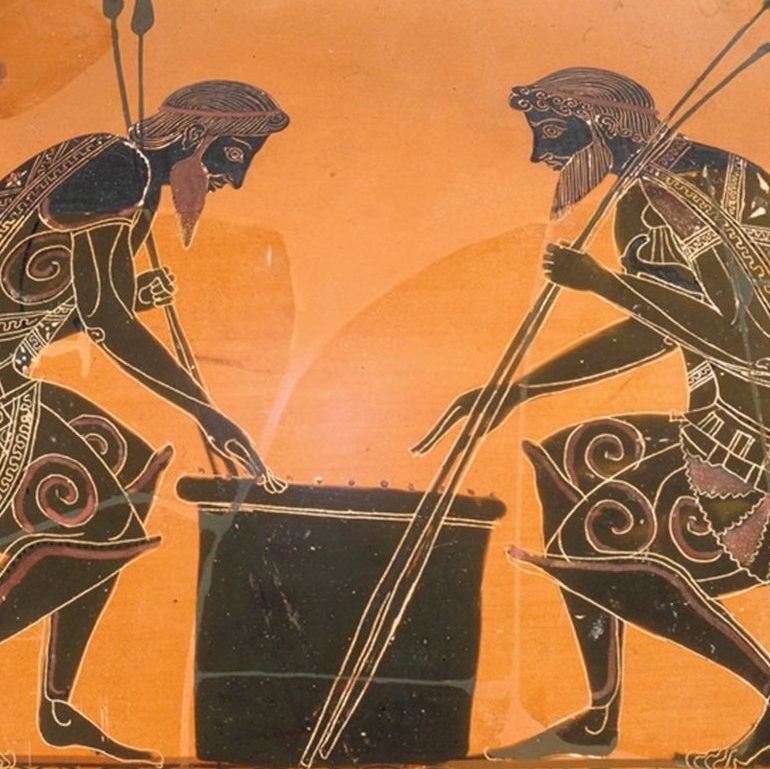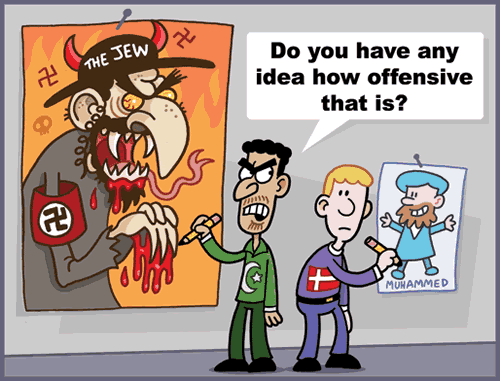So, post the Biden-visit contretemps, the Quartet, including the United States, has a second time condemned Israel’s housing construction plans in East Jerusalem, and the Netanyahu government has offered, privately, to take “confidence-building” measures to further the path of negotiations via the current “proximity talks” proposal. Where does that leave matters?
People who know internal Israeli politics and government processes far better than I have offered scenarios by which the housing start announcement during the Biden visit could have occurred without any intended insult. The intentional insult makes no sense in any analysis anyway, except one habitually hateful toward Israel and intended itself to promote the impression of Israeli arrogance. Unfortunately, appearances during a hateful period cooperate in reinforcing this general impression. Widespread and growing Israeli disgust and dismissal of the international bias against it, and a millennially-seasoned sense of beleaguered Jewish resistance, serve to reinforce the prevalent perception. The disgust is justified. The dismissal proves repeatedly to be counterproductive.
This last point should not be overstated. Even when Israel shows its best face, there is little if any reward in the public playhouse. The hate mongers were all over the low channels of media disparaging with anti-Semitic paranoia the extraordinary Israeli contribution in Haiti. The video below offers its own symbolic representation, in microcosm, of the Israeli-Palestinian conflict. Israeli ambassador to the United States Michael Oren confronts organized disruption of his recent speech at UC Irvine. In what is now the time-honored tradition of self-righteously preening student activists of all eras since the 60s, the students stand according to a choreography of ugly and cowardly denunciation even as it has been made clear to them by their Irvine hosts and by Oren himself that an actual exchange of ideas would be welcome. In the end, the students exit en masse, and Oren remarks sadly to the supportive audience that remains that he is happy to have them, but it is those who left to whom he needed and wished to speak. Substitute the Israeli acceptance of the 1948 partition, and a willingness to live in peace beside a new Arab neighbor, met by sixty plus years of rejection, war, and terror, and you have not a video short, but the full-length film.
Still, circumstances are what they are, and Jews have been masters at adapting to them.
There has been much speculation, too, about the motivations and strategy of the Obama administration. Two groups view the administration’s course very negatively. One is the Israelis themselves. Another is hawkish elements in the U.S. who despise Obama anyway and who project upon him an antipathy for Israel that is only a projection of their own for him, reinforced by his mishandling of Israel and the Palestinians.
The Israelis feel no favor on more reasonable grounds. What exactly has been the Obama plan? The focus on a blanket suspension of “settlement” activity, framed to include housing construction in East Jerusalem – which the U.S. well and long knew, and previously accepted, that Israel categorized differently from the West Bank – in effect mandated the Palestinians do the same and set such a suspension as a precondition for direct talks. A wasted year, and more, has ensued. That could have been no one’s plan.
do the same and set such a suspension as a precondition for direct talks. A wasted year, and more, has ensued. That could have been no one’s plan.
In addition to simple bungling, two other broad considerations are reasonable, not exclusive of that first. It is reasonable to perceive that uncritical support – love, let us say – of the kind the Bush administration demonstrated, may have done its job, as has lengthier U.S. support in general, in helping to maintain Israeli security, but it has achieved nothing since the Camp David accords in delivering peace or a final settlement. It may well be – I believe it is so – that the Obama administration wants to achieve a peace, and it is willing, in appearance, to love Israel a little less, and be loved back less by Israelis, in order to accomplish it. Foreign policy is, after all, not a love fest, even with allies. It is about pursuing national interests, and American national interests are neither served by Israeli settlements on the West Bank nor by exactly how much of Jerusalem Israel may retain after a final peace.
The second broad consideration, again not exclusive of the others, is that the Obama administration – and that must mean Obama himself – rather than perceive the consistent historical truth of The Refusal, has accepted the currently conventional Israel-Palestinian narrative, the “Israel-is-the-problem” narrative. That narrative assumes and even states outright the usual encomiums for Israel and the Jewish people, acknowledges all of the historical justifications for a Jewish state in Israel, but spins a tale that six decades of conflict-induced callousness, and over three decades of Biblically-driven acquisitiveness for the full extent of the ancient land, have made Israel – the party with the apparent power to give, in contrast to the Palestinians, who have so little – as much, or more, the obstacle to peace as the Palestinians.
How this narrative became conventionally accepted has been addressed by many, but to the degree that there was ever an element of truth, Barry Rubin has reminded us that such a storyline is already two decades out of date.
Among Palestinians, as more broadly with almost all of the public in the Muslim-majority world and a lot of the elite classes in Europe, there exists a mythical Israel, reminiscent of the fabricated antisemitic stereotypes of the past, that has little to do with reality. They believe Israel isn’t interested in peace, doesn’t offer the Palestinians anything, opposes any real Palestinian state, intends to keep the West Bank (until Israel’s withdrawal from all of the Gaza Strip they would have added that territory as well), and is led by intransigent hardliners. Such a conception was comprehensible–if not fully accurate–describing the situation in parts of the 1980s but has nothing to do with the last 20 years.
In 2010 they have no idea what Israel actually offered in the 1990s’ peace process, or at the Camp David summit in 2000, or what President Bill Clinton offered with Israel’s agreement in December 2000, or what Prime Minister Ehud Olmert proffered in 2008, or what is in the current Israeli government’s peace offer in 2010. All proposed the creation of an independent Palestinian state, the first three in close to 100 percent and the last three as equivalent to 100 percent (with some small, equal land swaps) in size to the pre-1967 West Bank and Gaza Strip.
Lacking any knowledge of these offers, or at least knowing only very distorted ones, they can maintain that Israel has offered “nothing” and that therefore the continuation of the conflict is not due to Palestinian intransigence but Israel’s alleged opposition to the creation of a real independent Palestinian state.
Remarkably, particularly so with Hilary Clinton as secretary of state, this is the storyline from which the Obama administration is attempting to write a final chapter.
Now consider, against the backdrop of the history Rubin briefly recapped – the several proposals over a near twenty-year period, far from its deepest wishes, that Israel has made or been ready to accept, against none by the Palestinians but their extreme starting position – consider how the Palestinians behave while the Quartet concentrates on longstanding housing policies in East Jerusalem.
- The unremitting, and well-known educational indoctrination in anti-Semitic hate via Palestinian schools and media, reported on most recently by the British Taxpayer’s Alliance, which is tracking British and European Union financial support for these activities.
- The glorification of inarguable murderers through public dedications and memorials, even as Israel is roundly being excoriated for constructing apartments, as soon as Vice-President Biden leaves the territories.
As window dressing, EgyptAir publishes online an interesting new map of the Middle East.
Yet the intensive bias against Israel is not merely the cultural manifestation of former foes and now supposed friends, as Noah Bernstein reports at OpenDemocracy in A media eclipse: Israel-Palestine and the world’s forgotten conflicts. (H/T Z Word Blog)
In a forty-eight hour period beginning on Christmas Eve 2008 the Christian fundamentalist Lord’s Resistance Army (LRA) killed, dismembered and burned at least 200 Congolese civilians. Soldiers raped women and girls, twisted the heads off babies, and cut the lips and ears off those they did not kill. They hacked the rest to death using machetes or axes. Child soldiers helped abduct other children.
During the same period the Israeli government and Hamas officials entered the final stages of failing ceasefire talks. War was on the horizon, but had not yet begun. An errant Hamas rocket killed two Gazan sisters; otherwise there were no cross-border casualties.
According to AlertNet’s World Press Tracker, the two-day Israeli-Palestinian stand-off was reported in the global media forty times.[i] There were no reports on the LRA massacre in the Democratic Republic of the Congo (DRC). Over the next three weeks Israel’s incursion into Gaza left 926 Palestinian and three Israeli civilians dead. The global media reported these events 2896 times. In the same period, Joseph Kony’s LRA killed 865 civilians and abducted 160 children. The media reported these events a total of twenty times.
The Western media’s fascination with the Israeli-Palestinian conflict has long overshadowed death and oppression in other parts of the world. Gilad Shalit and the Qassam rocket are known to many; the death of 5.9 million in the eight-nation Second Congo War is not. Recent Israeli and Palestinian elections were covered worldwide in real-time, while images of genocide in Rwanda and Sudan did not surface until it was too late. Countless articles argue media bias in favour of Israel or the Palestinians, yet few address the media bias towards the conflict itself.
These are all merely among the most up-to-the-minute representations of a complex of intellectual, ideological, and moral misalliances that constitute or contribute to anti-Zionism, even by many who do not think themselves anti-Zionist, who claim to be supporters of Israel. One contributing factor is the truism, repeated to the point of near triteness, that Israel has an “image” problem. But only the language can become trite, not the problem itself, and language cannot only be, but be made to be part of the problem.
To even speak of an “image” problem is to engage the superficial, to appear to be concerned only with appearance, and not the underlying substance. To be perceived as engaging appearances – appearances that, of course, can determine how people perceive substance (and this is why public relations exists) – is thus already to undermine a PR effort aimed, perhaps, only at more successfully disseminating the truth. The language of appearance, the language of influence, becomes part of the problem, a tool to be turned against Israel as a weapon. Note how Israel’s public diplomacy efforts, its public relations, expressed in Hebrew as hasbara, are turned against Israel via an almost invisible, instrumentally racialist linguistic campaign, in the persistent use, by non-Hebrew speakers, of the insidious foreign word – hasbara – which in its foreignness, its cognitive unfamiliarity, conveys the sinister concealment of true meaning and motive.
This quality of sinister concealment is not inherent in a word or a language. It is, in its foreignness, simply other, so the foreignness is appropriated as a vehicle for an attitude. The very reverse occurs in the standardized use of Intifada by non-Arabic speakers, a term that in its own foreignness, beyond its literal meaning, tends further to ennoble and hallow. In the reverse, again, how convenient for anti-Zionists and racists of all kinds that Jewish nationalism had its own word, Zionism. The very word is made unattractive through persistent labeling. It is not, certainly in English, a euphonic word. It shares that insidious “z” phoneme with – how curious, some must think – Nazi, which makes it easy to conjure the sinister in the voicing of it, an effect not lost on formative and progressive young political minds longing to be humane and just. Easy, then, in the shameful yet renascent past, to pass a U.N. resolution declaring Zionism a form of racism, like Nazism. Phonetic guilt by association helps poison the well.
What, then, to do? We can only speak in language, and we cannot regulate its use and misuse by free agents everywhere. What can be done, however, is to attach substance to substance, unyieldingly connect action to action. Whatever conditions for negotiations are placed on Israel by outside parties or demanded of it by the Palestinian authority, these conditions should be answered not simply by defensive explanation – as that the current policy of construction in East Jerusalem is the same as it has been for forty-two years, and that conditioning the policy now does not seek to clear the way to negotiations, but, in fact, to raise to obstacles to it. These conditions should, further, be consistently and unvaryingly linked to counter conditions.
The PA and the Quartet should be reminded without cessation that Israel is always ready to negotiate unconditionally, as it is now, but that for every condition placed on it, a condition in return will be demanded. Every demand on Israel should be countered by demands for systematic and verifiable alterations in Palestinian school curricula and textbooks and bans on media incitement to Jew hatred. Every time a PA representative or an EU or UN or even U.S. official mentions settlements or housing construction as an obstacle to peace, an Israeli official should speak publicly in response of hate education and anti-Semitic Palestinian media broadcasts. There should no official reference to one without official reference to the other.
Let the condemnation of settlements be faced page to opposing page with the glorification of martyrdom to children, and let’s find out how that story ends.
AJA
(All visual and text images from Palestinian Media Watch)
This entry was posted on Tuesday, March 23rd, 2010 at 4:00 am by A. Jay Adler and is filed under The Political Animal. | Edit
One Response to “Israel: Escaping the Image and Language Trap”
-
copithorne, on March 24th, 2010 at 4:33 am Said: Edit Comment
Do I understand that you perceive building Jewish settlements in East Jerusalem as business as usual and an unobjectionable Israeli perogative? Because everyone who truly knows what is going on knows that East Jerusalem will never be part of a Palestinian state?
I’m not as informed as you, so let me know.
Certainly it has been consistent US policy since Nixon that Israel should not build settlements as it defers and complicates peace and the US has an interest in peace.
And I support US aid to Israel and even some support that the US may have some responsibility for fighting proxy wars for Israel in the region. But reading your post, I’m left with the feeling that Israel is all grown up and wants to be all grown up and it’s past time to cut ties with Daddy’s wallet. If $4 billion doesn’t even buy us a halt to building settlements when our Vice President pays a visit — well, we’ve got to have some self respect. And it is not in our interest to underwrite policies that antagonize the region.
Maybe Turkey would go steady with us.
You argued persuasively in your torture post that recipiprocity did not constitute justification. And I’m left wondering if that bright line is as clear when you talk about Israel as it is when you talk about America. The fact that Palestinian educational practices are repugnant is not relevant to evaluating Israel’s behavior.
I recently saw a movie Zero Degrees of Separation — a liberal Israeli look at the occupation through the prism of gay relationships between Israelis and Palestinians. It illustrated what I’ve seen elsewhere that the occupied territories are run like a giant prison. And like all prisons, the guards and administration tend towards sadism. The occupation creates an environment of humiliation. The humiliation is not the minimum required for Israeli security. There is more to it than that.
One of the provocative thoughts of that movie was an Israeli woman noting that maybe 50 Israelis a year die from terrorism while 2500 Israeli women die from domestic violence. I wonder what explanations people would come up with why one risk commands the entire financial, military, and moral resources of a nation while the other risk gets a band aid.
I thought the movie was one sided. But it definitely confirmed to me that there are two sides to this story. Peacemakers will be those who can hold both sides.






























Excellent read, I just passed this onto a colleague who was doing a little research on that. And he actually bought me lunch because I found it for him smile So let me rephrase that: Thanks for lunch!
Do I understand that you perceive building Jewish settlements in East Jerusalem as business as usual and an unobjectionable Israeli perogative? Because everyone who truly knows what is going on knows that East Jerusalem will never be part of a Palestinian state?
I’m not as informed as you, so let me know.
Certainly it has been consistent US policy since Nixon that Israel should not build settlements as it defers and complicates peace and the US has an interest in peace.
And I support US aid to Israel and even some support that the US may have some responsibility for fighting proxy wars for Israel in the region. But reading your post, I’m left with the feeling that Israel is all grown up and wants to be all grown up and it’s past time to cut ties with Daddy’s wallet. If $4 billion doesn’t even buy us a halt to building settlements when our Vice President pays a visit — well, we’ve got to have some self respect. And it is not in our interest to underwrite policies that antagonize the region.
Maybe Turkey would go steady with us.
You argued persuasively in your torture post that recipiprocity did not constitute justification. And I’m left wondering if that bright line is as clear when you talk about Israel as it is when you talk about America. The fact that Palestinian educational practices are repugnant is not relevant to evaluating Israel’s behavior.
I recently saw a movie Zero Degrees of Separation — a liberal Israeli look at the occupation through the prism of gay relationships between Israelis and Palestinians. It illustrated what I’ve seen elsewhere that the occupied territories are run like a giant prison. And like all prisons, the guards and administration tend towards sadism. The occupation creates an environment of humiliation. The humiliation is not the minimum required for Israeli security. There is more to it than that.
One of the provocative thoughts of that movie was an Israeli woman noting that maybe 50 Israelis a year die from terrorism while 2500 Israeli women die from domestic violence. I wonder what explanations people would come up with why one risk commands the entire financial, military, and moral resources of a nation while the other risk gets a band aid.
I thought the movie was one sided. But it definitely confirmed to me that there are two sides to this story. Peacemakers will be those who can hold both sides.